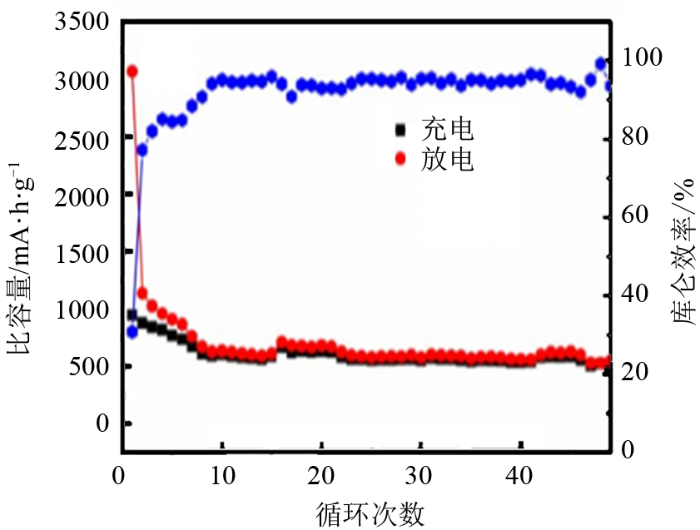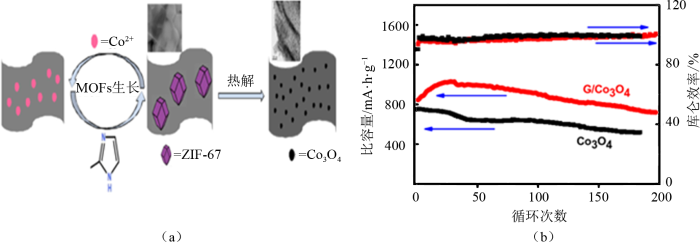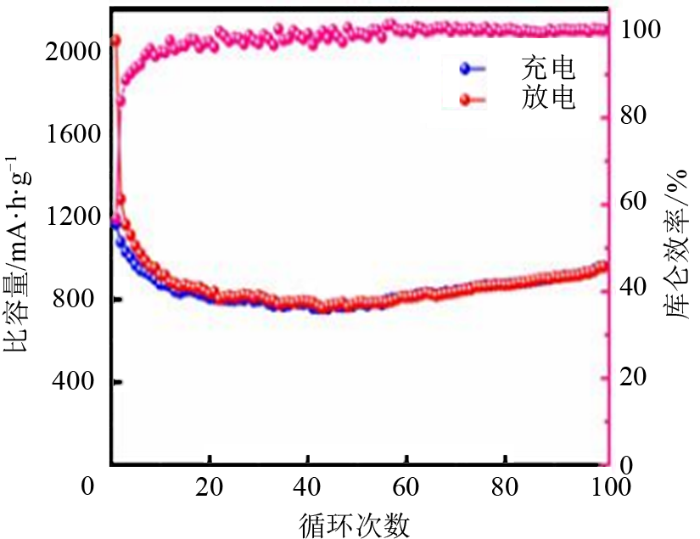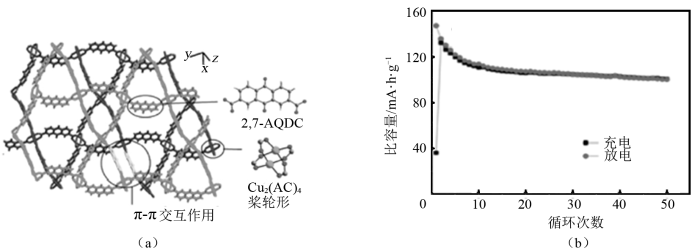Systematic design of pore size and functionality in isoreticular MOFs and their application in methane storage
1
2002
... 目前,商品化的锂离子电池的能量密度和循环性能难以跟上可移动用电设备快速发展的步伐.要提高锂离子电池能量密度和循环性能,需提供更多Li+扩散通道以及嵌入量,而多孔材料为解决此问题提供了一种途径.近年来出现的金属-有机骨架材料(metal-organic frameworks,MOFs)由于具有多孔、大的比表面积和结构可控的优点,发展极为迅速,已在气体吸附与分离、催化和电化学等领域得到了广泛的应用研究[1,2,3,4].MOFs及其衍生物不仅有利于Li+的迁移提高容量,而且可保证锂离子电池循环过程中的性能更为稳定[5].因此,MOFs及其衍生物是一种非常有潜力的锂离子电池电极材料.在此将对不同种类MOFs及其衍生物在锂离子电池负极和正极中的应用进行综述,并对目前MOFs在锂离子电池中存在的问题进行总结,指出未来发展的方向. ...
Acid-functionalized UIO-66(Zr) MOFs and their evolution after intra-framework cross-linking: Structural features and sorption properties
1
2015
... 目前,商品化的锂离子电池的能量密度和循环性能难以跟上可移动用电设备快速发展的步伐.要提高锂离子电池能量密度和循环性能,需提供更多Li+扩散通道以及嵌入量,而多孔材料为解决此问题提供了一种途径.近年来出现的金属-有机骨架材料(metal-organic frameworks,MOFs)由于具有多孔、大的比表面积和结构可控的优点,发展极为迅速,已在气体吸附与分离、催化和电化学等领域得到了广泛的应用研究[1,2,3,4].MOFs及其衍生物不仅有利于Li+的迁移提高容量,而且可保证锂离子电池循环过程中的性能更为稳定[5].因此,MOFs及其衍生物是一种非常有潜力的锂离子电池电极材料.在此将对不同种类MOFs及其衍生物在锂离子电池负极和正极中的应用进行综述,并对目前MOFs在锂离子电池中存在的问题进行总结,指出未来发展的方向. ...
Targeted synthesis of novel porous aromatic frameworks with selective separation of CO2/CH4 and CO2/N2
1
2014
... 目前,商品化的锂离子电池的能量密度和循环性能难以跟上可移动用电设备快速发展的步伐.要提高锂离子电池能量密度和循环性能,需提供更多Li+扩散通道以及嵌入量,而多孔材料为解决此问题提供了一种途径.近年来出现的金属-有机骨架材料(metal-organic frameworks,MOFs)由于具有多孔、大的比表面积和结构可控的优点,发展极为迅速,已在气体吸附与分离、催化和电化学等领域得到了广泛的应用研究[1,2,3,4].MOFs及其衍生物不仅有利于Li+的迁移提高容量,而且可保证锂离子电池循环过程中的性能更为稳定[5].因此,MOFs及其衍生物是一种非常有潜力的锂离子电池电极材料.在此将对不同种类MOFs及其衍生物在锂离子电池负极和正极中的应用进行综述,并对目前MOFs在锂离子电池中存在的问题进行总结,指出未来发展的方向. ...
Metal-organic frameworks for artificial photosynthesis and photocatalysis
1
2014
... 目前,商品化的锂离子电池的能量密度和循环性能难以跟上可移动用电设备快速发展的步伐.要提高锂离子电池能量密度和循环性能,需提供更多Li+扩散通道以及嵌入量,而多孔材料为解决此问题提供了一种途径.近年来出现的金属-有机骨架材料(metal-organic frameworks,MOFs)由于具有多孔、大的比表面积和结构可控的优点,发展极为迅速,已在气体吸附与分离、催化和电化学等领域得到了广泛的应用研究[1,2,3,4].MOFs及其衍生物不仅有利于Li+的迁移提高容量,而且可保证锂离子电池循环过程中的性能更为稳定[5].因此,MOFs及其衍生物是一种非常有潜力的锂离子电池电极材料.在此将对不同种类MOFs及其衍生物在锂离子电池负极和正极中的应用进行综述,并对目前MOFs在锂离子电池中存在的问题进行总结,指出未来发展的方向. ...
Metal-organic frameworks for energy storage: Batteries and supercapacitors
1
2016
... 目前,商品化的锂离子电池的能量密度和循环性能难以跟上可移动用电设备快速发展的步伐.要提高锂离子电池能量密度和循环性能,需提供更多Li+扩散通道以及嵌入量,而多孔材料为解决此问题提供了一种途径.近年来出现的金属-有机骨架材料(metal-organic frameworks,MOFs)由于具有多孔、大的比表面积和结构可控的优点,发展极为迅速,已在气体吸附与分离、催化和电化学等领域得到了广泛的应用研究[1,2,3,4].MOFs及其衍生物不仅有利于Li+的迁移提高容量,而且可保证锂离子电池循环过程中的性能更为稳定[5].因此,MOFs及其衍生物是一种非常有潜力的锂离子电池电极材料.在此将对不同种类MOFs及其衍生物在锂离子电池负极和正极中的应用进行综述,并对目前MOFs在锂离子电池中存在的问题进行总结,指出未来发展的方向. ...
Facile formation of a nanostructured NiP2@C material for advanced lithium-ion battery anode using adsorption property of metal-organic framework
1
2016
... 目前,石墨是锂离子电池最常用的负极材料,但其理论比容量只有372 mA·h/g,不能承受较大电流放电[6].由于MOFs的金属中心和有机配体都具有较好的电荷负载能力,有利于提高比容量,多孔的结构也有利于Li+在充放电过程中快速脱嵌,并且以MOFs为前体还可合成相应的金属氧化物和碳材料直接作为负极材料使用.因此,MOFs在锂电池负极中的研究较为全面,常见的MOFs主要有MIL系列、MOF系列、ZIF系列和普鲁士蓝系列. ...
A chromium terephthalate-based solid with unusually large pore volumes and surface area
1
2005
... MIL(materials of institut lavoisier)系列是由Ferey研究组首次合成,这种材料最大特点就是骨架极具柔韧性[7,8].MIL系列被最早用作锂电池电极,Li等[9]研究发现MIL-101(Cr)充放电容量较低,但引入GO(氧化石墨烯)后,放电容量约是MIL-101(Cr)放电容量的两倍(图1),这主要是由于引入GO后,使MIL-101(Cr)均匀分布在GO表面,提升了MIL-101(Cr)的放电容量. ...
Hydrogen adsorption in the nanoporous metal-benzenedicarboxylate M(OH)(O2C–C6H4–CO2)(M=Al3+, Cr3+), MIL-53
1
2003
... MIL(materials of institut lavoisier)系列是由Ferey研究组首次合成,这种材料最大特点就是骨架极具柔韧性[7,8].MIL系列被最早用作锂电池电极,Li等[9]研究发现MIL-101(Cr)充放电容量较低,但引入GO(氧化石墨烯)后,放电容量约是MIL-101(Cr)放电容量的两倍(图1),这主要是由于引入GO后,使MIL-101(Cr)均匀分布在GO表面,提升了MIL-101(Cr)的放电容量. ...
Graphene oxides doped MIL-101(Cr) as anode materials for enhanced electrochemistry performance of lithium ion battery
1
2016
... MIL(materials of institut lavoisier)系列是由Ferey研究组首次合成,这种材料最大特点就是骨架极具柔韧性[7,8].MIL系列被最早用作锂电池电极,Li等[9]研究发现MIL-101(Cr)充放电容量较低,但引入GO(氧化石墨烯)后,放电容量约是MIL-101(Cr)放电容量的两倍(图1),这主要是由于引入GO后,使MIL-101(Cr)均匀分布在GO表面,提升了MIL-101(Cr)的放电容量. ...
基于金属有机骨架材料为前驱物的锂电负极材料α-Fe2O3的合成及性能表征
1
2016
... 铁氧化物由于理论容量较高和结构稳定的特点,在锂电池负极领域受到很大关注.赵思维等[10]以MIL-53-Fe为前体制备出α-Fe2O3并用作锂离电池负极,在40次循环后库仑效率稳定在97%左右,这主要是40次循环后电极表面形成了一定厚度且稳定的SEI(电解质界面膜),导致表现出较好的稳定性能.将铁氧化物与其他物质形成复合材料也表现出较好的循环稳定性能,Li等[11]以MIL-88-Fe-FeC2O4·2H2O作为前体制备出C-Fe3O4微球用作锂电池负极,在50次循环之后仍保持了975 mA·h/g-1的较高放电容量(图2).铁氧化物与其他物质形成的核壳结构展现出的循环稳定性更优,Huang等[12]将Fe2Ni MIL-88/Fe MIL-88纳米棒退火后获得核壳结构的NiFe2O4/Fe2O3纳米管,展示出优异的性能,100次循环后还有高达936.9 mA·h/g的容量,并且库仑效率一直保持在98%左右,在相同测试条件下,性能远高于NiFe2O4. ...
基于金属有机骨架材料为前驱物的锂电负极材料α-Fe2O3的合成及性能表征
1
2016
... 铁氧化物由于理论容量较高和结构稳定的特点,在锂电池负极领域受到很大关注.赵思维等[10]以MIL-53-Fe为前体制备出α-Fe2O3并用作锂离电池负极,在40次循环后库仑效率稳定在97%左右,这主要是40次循环后电极表面形成了一定厚度且稳定的SEI(电解质界面膜),导致表现出较好的稳定性能.将铁氧化物与其他物质形成复合材料也表现出较好的循环稳定性能,Li等[11]以MIL-88-Fe-FeC2O4·2H2O作为前体制备出C-Fe3O4微球用作锂电池负极,在50次循环之后仍保持了975 mA·h/g-1的较高放电容量(图2).铁氧化物与其他物质形成的核壳结构展现出的循环稳定性更优,Huang等[12]将Fe2Ni MIL-88/Fe MIL-88纳米棒退火后获得核壳结构的NiFe2O4/Fe2O3纳米管,展示出优异的性能,100次循环后还有高达936.9 mA·h/g的容量,并且库仑效率一直保持在98%左右,在相同测试条件下,性能远高于NiFe2O4. ...
Large-scale fabrication of porous carbon-decorated iron oxide microcuboids from Fe-MOF as high-performance anode materials for lithium-ion batteries
1
2015
... 铁氧化物由于理论容量较高和结构稳定的特点,在锂电池负极领域受到很大关注.赵思维等[10]以MIL-53-Fe为前体制备出α-Fe2O3并用作锂离电池负极,在40次循环后库仑效率稳定在97%左右,这主要是40次循环后电极表面形成了一定厚度且稳定的SEI(电解质界面膜),导致表现出较好的稳定性能.将铁氧化物与其他物质形成复合材料也表现出较好的循环稳定性能,Li等[11]以MIL-88-Fe-FeC2O4·2H2O作为前体制备出C-Fe3O4微球用作锂电池负极,在50次循环之后仍保持了975 mA·h/g-1的较高放电容量(图2).铁氧化物与其他物质形成的核壳结构展现出的循环稳定性更优,Huang等[12]将Fe2Ni MIL-88/Fe MIL-88纳米棒退火后获得核壳结构的NiFe2O4/Fe2O3纳米管,展示出优异的性能,100次循环后还有高达936.9 mA·h/g的容量,并且库仑效率一直保持在98%左右,在相同测试条件下,性能远高于NiFe2O4. ...
Hierarchical NiFe2O4/Fe2O3 nanotubes derived from metal organic frameworks for superior lithium ion battery anodes
1
2014
... 铁氧化物由于理论容量较高和结构稳定的特点,在锂电池负极领域受到很大关注.赵思维等[10]以MIL-53-Fe为前体制备出α-Fe2O3并用作锂离电池负极,在40次循环后库仑效率稳定在97%左右,这主要是40次循环后电极表面形成了一定厚度且稳定的SEI(电解质界面膜),导致表现出较好的稳定性能.将铁氧化物与其他物质形成复合材料也表现出较好的循环稳定性能,Li等[11]以MIL-88-Fe-FeC2O4·2H2O作为前体制备出C-Fe3O4微球用作锂电池负极,在50次循环之后仍保持了975 mA·h/g-1的较高放电容量(图2).铁氧化物与其他物质形成的核壳结构展现出的循环稳定性更优,Huang等[12]将Fe2Ni MIL-88/Fe MIL-88纳米棒退火后获得核壳结构的NiFe2O4/Fe2O3纳米管,展示出优异的性能,100次循环后还有高达936.9 mA·h/g的容量,并且库仑效率一直保持在98%左右,在相同测试条件下,性能远高于NiFe2O4. ...
Porous carbon derived from metal-organic framework as an anode for lithium-ion batteries with improved performance
1
2017
... MOF系列是Yaghi等首次合成,此种材料稳定性良好,比表面积高,孔道结构规则.MOF系列在锂电池负极的应用主要是以其为模板获得多孔金属氧化物.多孔碳在电化学中已广泛应用,Luo等[13]报道了以新型Co-MOF作为模板,通过高温碳化和酸化之后合成多孔碳.将其用作锂电池负极时,展现出优良性能.在首次循环中,初始放电和充电容量分别达到3066 mA·h/g和946 mA·h/g,并且经50次循环后放电比容量仍保持在549 mA·h/g,相应的库仑效率也高达95%左右(图3),各种性能远远好于商品石墨. ...
Mesoporous nanostructured Co3O4 derived from MOF template: A high-performance anode material for lithium-ion batteries
1
2015
... Co3O4由于具有高的理论容量,是最受关注的钴基氧化物负极材料,但其存在循环过程中的体积膨胀等问题.Li等[14]通过对MOF-71-[Co(bdc)(DMF)]在不同温度下退火获得具有较高的比表面积、合理的孔容和小晶粒尺寸的中孔纳米Co3O4,60次循环后,450 ℃下获得的Co3O4容量迅速降低到450 mA·h/g以下,而300 ℃时的Co3O4仍有913 mA·h/g,这可能是由于300 ℃时获得的Co3O4电极阻抗低于450 ℃时的Co3O4,导致300 ℃时获得的Co3O4电极具有更好的导电能力.除钴基氧化物外,Mn2O3也备受关注.Bai等[15]将Mn-LCP在高温煅烧下合成多孔Mn2O3[图4(a)],并将其用于锂电池负极.多孔Mn2O3在250次循环后仍然能够保持705 mA·h/g的高放电比容量,而无孔Mn2O3迅速降至200 mA·h/g[图4(b)].这主要是由于多孔结构为电极和电解质提供了较大接触面积,并且在Li+的嵌入/嵌出过程中提供了足够大的空间以适应体积的变化.此外,这里的多孔Mn2O3电化学性能也好于其他报道的Mn2O3电极材料[16,17,18]. ...
MOFs-derived porous Mn2O3 as high-performance anode material for Li-ion battery
1
2015
... Co3O4由于具有高的理论容量,是最受关注的钴基氧化物负极材料,但其存在循环过程中的体积膨胀等问题.Li等[14]通过对MOF-71-[Co(bdc)(DMF)]在不同温度下退火获得具有较高的比表面积、合理的孔容和小晶粒尺寸的中孔纳米Co3O4,60次循环后,450 ℃下获得的Co3O4容量迅速降低到450 mA·h/g以下,而300 ℃时的Co3O4仍有913 mA·h/g,这可能是由于300 ℃时获得的Co3O4电极阻抗低于450 ℃时的Co3O4,导致300 ℃时获得的Co3O4电极具有更好的导电能力.除钴基氧化物外,Mn2O3也备受关注.Bai等[15]将Mn-LCP在高温煅烧下合成多孔Mn2O3[图4(a)],并将其用于锂电池负极.多孔Mn2O3在250次循环后仍然能够保持705 mA·h/g的高放电比容量,而无孔Mn2O3迅速降至200 mA·h/g[图4(b)].这主要是由于多孔结构为电极和电解质提供了较大接触面积,并且在Li+的嵌入/嵌出过程中提供了足够大的空间以适应体积的变化.此外,这里的多孔Mn2O3电化学性能也好于其他报道的Mn2O3电极材料[16,17,18]. ...
Morphology-conserved transformation: Synthesis of hierarchical mesoporous nanostructures of Mn2O3 and the nanostructural effects on Li-ion insertion/deinsertion properties
1
2011
... Co3O4由于具有高的理论容量,是最受关注的钴基氧化物负极材料,但其存在循环过程中的体积膨胀等问题.Li等[14]通过对MOF-71-[Co(bdc)(DMF)]在不同温度下退火获得具有较高的比表面积、合理的孔容和小晶粒尺寸的中孔纳米Co3O4,60次循环后,450 ℃下获得的Co3O4容量迅速降低到450 mA·h/g以下,而300 ℃时的Co3O4仍有913 mA·h/g,这可能是由于300 ℃时获得的Co3O4电极阻抗低于450 ℃时的Co3O4,导致300 ℃时获得的Co3O4电极具有更好的导电能力.除钴基氧化物外,Mn2O3也备受关注.Bai等[15]将Mn-LCP在高温煅烧下合成多孔Mn2O3[图4(a)],并将其用于锂电池负极.多孔Mn2O3在250次循环后仍然能够保持705 mA·h/g的高放电比容量,而无孔Mn2O3迅速降至200 mA·h/g[图4(b)].这主要是由于多孔结构为电极和电解质提供了较大接触面积,并且在Li+的嵌入/嵌出过程中提供了足够大的空间以适应体积的变化.此外,这里的多孔Mn2O3电化学性能也好于其他报道的Mn2O3电极材料[16,17,18]. ...
Synthesis of Mn2O3 nanomaterials with controllable porosity and thickness for enhanced lithium-ion batteries performance
1
2014
... Co3O4由于具有高的理论容量,是最受关注的钴基氧化物负极材料,但其存在循环过程中的体积膨胀等问题.Li等[14]通过对MOF-71-[Co(bdc)(DMF)]在不同温度下退火获得具有较高的比表面积、合理的孔容和小晶粒尺寸的中孔纳米Co3O4,60次循环后,450 ℃下获得的Co3O4容量迅速降低到450 mA·h/g以下,而300 ℃时的Co3O4仍有913 mA·h/g,这可能是由于300 ℃时获得的Co3O4电极阻抗低于450 ℃时的Co3O4,导致300 ℃时获得的Co3O4电极具有更好的导电能力.除钴基氧化物外,Mn2O3也备受关注.Bai等[15]将Mn-LCP在高温煅烧下合成多孔Mn2O3[图4(a)],并将其用于锂电池负极.多孔Mn2O3在250次循环后仍然能够保持705 mA·h/g的高放电比容量,而无孔Mn2O3迅速降至200 mA·h/g[图4(b)].这主要是由于多孔结构为电极和电解质提供了较大接触面积,并且在Li+的嵌入/嵌出过程中提供了足够大的空间以适应体积的变化.此外,这里的多孔Mn2O3电化学性能也好于其他报道的Mn2O3电极材料[16,17,18]. ...
Porous Mn2O3 microsphere as a superior anode material for lithium ion batteries
1
2012
... Co3O4由于具有高的理论容量,是最受关注的钴基氧化物负极材料,但其存在循环过程中的体积膨胀等问题.Li等[14]通过对MOF-71-[Co(bdc)(DMF)]在不同温度下退火获得具有较高的比表面积、合理的孔容和小晶粒尺寸的中孔纳米Co3O4,60次循环后,450 ℃下获得的Co3O4容量迅速降低到450 mA·h/g以下,而300 ℃时的Co3O4仍有913 mA·h/g,这可能是由于300 ℃时获得的Co3O4电极阻抗低于450 ℃时的Co3O4,导致300 ℃时获得的Co3O4电极具有更好的导电能力.除钴基氧化物外,Mn2O3也备受关注.Bai等[15]将Mn-LCP在高温煅烧下合成多孔Mn2O3[图4(a)],并将其用于锂电池负极.多孔Mn2O3在250次循环后仍然能够保持705 mA·h/g的高放电比容量,而无孔Mn2O3迅速降至200 mA·h/g[图4(b)].这主要是由于多孔结构为电极和电解质提供了较大接触面积,并且在Li+的嵌入/嵌出过程中提供了足够大的空间以适应体积的变化.此外,这里的多孔Mn2O3电化学性能也好于其他报道的Mn2O3电极材料[16,17,18]. ...
Graphene oxides-guided growth of ultrafine Co3O4 nanocrystallites from MOFs as high-performance anode of Li-ion batteries
2
2015
... 除MOF系列外,Yaghi研究组首次合成的ZIF(zeolitic imidazolate framework)系列也常被用作前体来制备锂电池负极,此类材料具有大的表面积、高的热稳定性和极好的化学稳定性.钴氧化物也可由ZIF系列材料获得,Qu等[19]在氧化石墨烯(GO)纳米片上自组装生长ZIF-67,后通过热解得到GO/Co3O4复合材料[图5(a)].将其用作负极时,第30次循环中达到最大容量1029 mA·h/g,并在第100和200次循环后分别有908 mA·h/g和714 mA·h/g的高容量,远高于未复合GO的Co3O4[图5(b)].这可能是由于Co3O4与GO纳米片之间的空间可以很好地缓冲Li+嵌入/嵌出带来的体积变化,并且GO纳米片可以使Co3O4取得很好的分散效果.受此启发,Liu等[20]通过共沉淀法制备出GO@ZIF和ZIF-GO-ZIF复合材料,并在高温处理下相应地得到RGO@Co3O4和Co3O4-RGO-Co3O4,两者分别作为锂电池负极后,经100次循环后容量分别稳定于974 mA·h/g和813 mA·h/g的高容量,较文献[19]表现出更好的性能.CoS2由于具有高超导电性,在锂电池负极材料中的应用也有很好的前景.Wang等[21]对ZIF-67经过简单的低温硫化处理,获得CoS2分散在富N的多孔碳中的CoS2复合材料——NC/CoS2,对其作为锂电池负极进行了研究,结果显示即使在2500 mA/g的高电流密度下,也有难得的410 mA·h/g的可逆容量,这归因与超小CoS2颗粒和富含N的多孔碳壳的良好协同作用. ...
... h/g的高容量,较文献[19]表现出更好的性能.CoS2由于具有高超导电性,在锂电池负极材料中的应用也有很好的前景.Wang等[21]对ZIF-67经过简单的低温硫化处理,获得CoS2分散在富N的多孔碳中的CoS2复合材料——NC/CoS2,对其作为锂电池负极进行了研究,结果显示即使在2500 mA/g的高电流密度下,也有难得的410 mA·h/g的可逆容量,这归因与超小CoS2颗粒和富含N的多孔碳壳的良好协同作用. ...
MOF-derived hollow Co9S8 nanoparticles embedded in graphitic carbon nanocages with superior Li-ion storage
1
2016
... 除MOF系列外,Yaghi研究组首次合成的ZIF(zeolitic imidazolate framework)系列也常被用作前体来制备锂电池负极,此类材料具有大的表面积、高的热稳定性和极好的化学稳定性.钴氧化物也可由ZIF系列材料获得,Qu等[19]在氧化石墨烯(GO)纳米片上自组装生长ZIF-67,后通过热解得到GO/Co3O4复合材料[图5(a)].将其用作负极时,第30次循环中达到最大容量1029 mA·h/g,并在第100和200次循环后分别有908 mA·h/g和714 mA·h/g的高容量,远高于未复合GO的Co3O4[图5(b)].这可能是由于Co3O4与GO纳米片之间的空间可以很好地缓冲Li+嵌入/嵌出带来的体积变化,并且GO纳米片可以使Co3O4取得很好的分散效果.受此启发,Liu等[20]通过共沉淀法制备出GO@ZIF和ZIF-GO-ZIF复合材料,并在高温处理下相应地得到RGO@Co3O4和Co3O4-RGO-Co3O4,两者分别作为锂电池负极后,经100次循环后容量分别稳定于974 mA·h/g和813 mA·h/g的高容量,较文献[19]表现出更好的性能.CoS2由于具有高超导电性,在锂电池负极材料中的应用也有很好的前景.Wang等[21]对ZIF-67经过简单的低温硫化处理,获得CoS2分散在富N的多孔碳中的CoS2复合材料——NC/CoS2,对其作为锂电池负极进行了研究,结果显示即使在2500 mA/g的高电流密度下,也有难得的410 mA·h/g的可逆容量,这归因与超小CoS2颗粒和富含N的多孔碳壳的良好协同作用. ...
Facile synthesis of ultrasmall CoS2 nanoparticles within thin N-doped porous carbon shell for high performance lithium-ion batteries
1
2015
... 除MOF系列外,Yaghi研究组首次合成的ZIF(zeolitic imidazolate framework)系列也常被用作前体来制备锂电池负极,此类材料具有大的表面积、高的热稳定性和极好的化学稳定性.钴氧化物也可由ZIF系列材料获得,Qu等[19]在氧化石墨烯(GO)纳米片上自组装生长ZIF-67,后通过热解得到GO/Co3O4复合材料[图5(a)].将其用作负极时,第30次循环中达到最大容量1029 mA·h/g,并在第100和200次循环后分别有908 mA·h/g和714 mA·h/g的高容量,远高于未复合GO的Co3O4[图5(b)].这可能是由于Co3O4与GO纳米片之间的空间可以很好地缓冲Li+嵌入/嵌出带来的体积变化,并且GO纳米片可以使Co3O4取得很好的分散效果.受此启发,Liu等[20]通过共沉淀法制备出GO@ZIF和ZIF-GO-ZIF复合材料,并在高温处理下相应地得到RGO@Co3O4和Co3O4-RGO-Co3O4,两者分别作为锂电池负极后,经100次循环后容量分别稳定于974 mA·h/g和813 mA·h/g的高容量,较文献[19]表现出更好的性能.CoS2由于具有高超导电性,在锂电池负极材料中的应用也有很好的前景.Wang等[21]对ZIF-67经过简单的低温硫化处理,获得CoS2分散在富N的多孔碳中的CoS2复合材料——NC/CoS2,对其作为锂电池负极进行了研究,结果显示即使在2500 mA/g的高电流密度下,也有难得的410 mA·h/g的可逆容量,这归因与超小CoS2颗粒和富含N的多孔碳壳的良好协同作用. ...
A robust hybrid of SnO2 nanoparticles sheathed by N-doped carbon derived from ZIF-8 as anodes for Li ion batteries
1
2017
... 阻较大不适合作为电极材料,但研究发现对其掺杂修饰后也可获得较高的比容量.Yang等[22]先将ZIF-8在高温碳化后形成氮掺杂多孔碳材料(NC),再通过气相沉积法将纳米SnO2引入到NC中形成SnO2-NC复合材料,在电流密度为500 mA/g,循环200次后放电容量达667.1 mA·h/g,表明电池循环性能较为良好.更重要的是,充放电完成后材料的结构几无变化,保持了原来完整的结构. ...
Formation of Fe2O3 microboxes with hierarchical shell structures from metal-organic frameworks and their lithium storage properties
1
2012
... 由于具有形貌规则、独特的稳定性和电催化活性等特点,普鲁士蓝及不同过渡金属形成的类普鲁士蓝结构衍生物修饰的电极也引起了高度的关注.Zhang等[23]在不同温度下退火Fe4[Fe(CN)6]3获得不同形貌的Fe2O3微球,将其用作负极时,具有分层结构的Fe2O3微球展现出更高的比容量和循环稳定性.为获得双金属锂电池负极材料,Yang等[24]以K4[Fe(CN)6]/3H2O与Cu(NO)3/H2O合成具有Fe和Cu的双金属MOF,并以此为模板得到Fe2O3-CuO复合材料,发现循环120次后仍保持744 mA·h/g的较高容量,并且循环稳定性也好于其他过渡金属氧化物[25,26,27].Zheng等[28]以Zn3[Co(CN)6]2为模板获得ZnO/Co3O4复合材料,将其作为锂电池负极时,表现出较上种材料更好的电化学性能(图6).上述普鲁士蓝结构衍生物表现出的较好的电化学性能主要是由于多孔的结构增强了物质稳定性和复合之后体系的协同效应,同时也很好地缓冲了Li+的嵌入/嵌出过程中的体积变化.普鲁士蓝类似物也可制备出核壳结构锂电池负极材料,Huang等[29]在空气中退火MOF-Co3[Fe(CN)6]2@Ni3[Co(CN)6]2,获得核壳结构的Fe2O3@NiCo2O4多孔纳米块体,用作锂电池负极展现出相当高的容量以及优异的循环稳定性,这归因于此种核壳结构较上述复合材料具有更好的协同效应. ...
Lithium ion battery application of porous composite oxide microcubes prepared via metal-organic frameworks
1
2015
... 由于具有形貌规则、独特的稳定性和电催化活性等特点,普鲁士蓝及不同过渡金属形成的类普鲁士蓝结构衍生物修饰的电极也引起了高度的关注.Zhang等[23]在不同温度下退火Fe4[Fe(CN)6]3获得不同形貌的Fe2O3微球,将其用作负极时,具有分层结构的Fe2O3微球展现出更高的比容量和循环稳定性.为获得双金属锂电池负极材料,Yang等[24]以K4[Fe(CN)6]/3H2O与Cu(NO)3/H2O合成具有Fe和Cu的双金属MOF,并以此为模板得到Fe2O3-CuO复合材料,发现循环120次后仍保持744 mA·h/g的较高容量,并且循环稳定性也好于其他过渡金属氧化物[25,26,27].Zheng等[28]以Zn3[Co(CN)6]2为模板获得ZnO/Co3O4复合材料,将其作为锂电池负极时,表现出较上种材料更好的电化学性能(图6).上述普鲁士蓝结构衍生物表现出的较好的电化学性能主要是由于多孔的结构增强了物质稳定性和复合之后体系的协同效应,同时也很好地缓冲了Li+的嵌入/嵌出过程中的体积变化.普鲁士蓝类似物也可制备出核壳结构锂电池负极材料,Huang等[29]在空气中退火MOF-Co3[Fe(CN)6]2@Ni3[Co(CN)6]2,获得核壳结构的Fe2O3@NiCo2O4多孔纳米块体,用作锂电池负极展现出相当高的容量以及优异的循环稳定性,这归因于此种核壳结构较上述复合材料具有更好的协同效应. ...
Rationally designed hierarchical TiO2@Fe2O3 hollow nanostructures for improved lithium ion storage
1
2013
... 由于具有形貌规则、独特的稳定性和电催化活性等特点,普鲁士蓝及不同过渡金属形成的类普鲁士蓝结构衍生物修饰的电极也引起了高度的关注.Zhang等[23]在不同温度下退火Fe4[Fe(CN)6]3获得不同形貌的Fe2O3微球,将其用作负极时,具有分层结构的Fe2O3微球展现出更高的比容量和循环稳定性.为获得双金属锂电池负极材料,Yang等[24]以K4[Fe(CN)6]/3H2O与Cu(NO)3/H2O合成具有Fe和Cu的双金属MOF,并以此为模板得到Fe2O3-CuO复合材料,发现循环120次后仍保持744 mA·h/g的较高容量,并且循环稳定性也好于其他过渡金属氧化物[25,26,27].Zheng等[28]以Zn3[Co(CN)6]2为模板获得ZnO/Co3O4复合材料,将其作为锂电池负极时,表现出较上种材料更好的电化学性能(图6).上述普鲁士蓝结构衍生物表现出的较好的电化学性能主要是由于多孔的结构增强了物质稳定性和复合之后体系的协同效应,同时也很好地缓冲了Li+的嵌入/嵌出过程中的体积变化.普鲁士蓝类似物也可制备出核壳结构锂电池负极材料,Huang等[29]在空气中退火MOF-Co3[Fe(CN)6]2@Ni3[Co(CN)6]2,获得核壳结构的Fe2O3@NiCo2O4多孔纳米块体,用作锂电池负极展现出相当高的容量以及优异的循环稳定性,这归因于此种核壳结构较上述复合材料具有更好的协同效应. ...
Prussion blue-supported annealing chemical reaction route synthesized double-shelled Fe2O3/Co3O4 hollow microcubes as anode materials for lithium-ion battery
1
2014
... 由于具有形貌规则、独特的稳定性和电催化活性等特点,普鲁士蓝及不同过渡金属形成的类普鲁士蓝结构衍生物修饰的电极也引起了高度的关注.Zhang等[23]在不同温度下退火Fe4[Fe(CN)6]3获得不同形貌的Fe2O3微球,将其用作负极时,具有分层结构的Fe2O3微球展现出更高的比容量和循环稳定性.为获得双金属锂电池负极材料,Yang等[24]以K4[Fe(CN)6]/3H2O与Cu(NO)3/H2O合成具有Fe和Cu的双金属MOF,并以此为模板得到Fe2O3-CuO复合材料,发现循环120次后仍保持744 mA·h/g的较高容量,并且循环稳定性也好于其他过渡金属氧化物[25,26,27].Zheng等[28]以Zn3[Co(CN)6]2为模板获得ZnO/Co3O4复合材料,将其作为锂电池负极时,表现出较上种材料更好的电化学性能(图6).上述普鲁士蓝结构衍生物表现出的较好的电化学性能主要是由于多孔的结构增强了物质稳定性和复合之后体系的协同效应,同时也很好地缓冲了Li+的嵌入/嵌出过程中的体积变化.普鲁士蓝类似物也可制备出核壳结构锂电池负极材料,Huang等[29]在空气中退火MOF-Co3[Fe(CN)6]2@Ni3[Co(CN)6]2,获得核壳结构的Fe2O3@NiCo2O4多孔纳米块体,用作锂电池负极展现出相当高的容量以及优异的循环稳定性,这归因于此种核壳结构较上述复合材料具有更好的协同效应. ...
Modification of carbon nanotubes by CuO-doped NiO nanocomposite for use as an anode material for lithium-ion batteries
1
2013
... 由于具有形貌规则、独特的稳定性和电催化活性等特点,普鲁士蓝及不同过渡金属形成的类普鲁士蓝结构衍生物修饰的电极也引起了高度的关注.Zhang等[23]在不同温度下退火Fe4[Fe(CN)6]3获得不同形貌的Fe2O3微球,将其用作负极时,具有分层结构的Fe2O3微球展现出更高的比容量和循环稳定性.为获得双金属锂电池负极材料,Yang等[24]以K4[Fe(CN)6]/3H2O与Cu(NO)3/H2O合成具有Fe和Cu的双金属MOF,并以此为模板得到Fe2O3-CuO复合材料,发现循环120次后仍保持744 mA·h/g的较高容量,并且循环稳定性也好于其他过渡金属氧化物[25,26,27].Zheng等[28]以Zn3[Co(CN)6]2为模板获得ZnO/Co3O4复合材料,将其作为锂电池负极时,表现出较上种材料更好的电化学性能(图6).上述普鲁士蓝结构衍生物表现出的较好的电化学性能主要是由于多孔的结构增强了物质稳定性和复合之后体系的协同效应,同时也很好地缓冲了Li+的嵌入/嵌出过程中的体积变化.普鲁士蓝类似物也可制备出核壳结构锂电池负极材料,Huang等[29]在空气中退火MOF-Co3[Fe(CN)6]2@Ni3[Co(CN)6]2,获得核壳结构的Fe2O3@NiCo2O4多孔纳米块体,用作锂电池负极展现出相当高的容量以及优异的循环稳定性,这归因于此种核壳结构较上述复合材料具有更好的协同效应. ...
MOF-derived self-assembled ZnO/Co3O4 nanocomposite clusters as high-performance anodes for lithium-ion batteries
1
2015
... 由于具有形貌规则、独特的稳定性和电催化活性等特点,普鲁士蓝及不同过渡金属形成的类普鲁士蓝结构衍生物修饰的电极也引起了高度的关注.Zhang等[23]在不同温度下退火Fe4[Fe(CN)6]3获得不同形貌的Fe2O3微球,将其用作负极时,具有分层结构的Fe2O3微球展现出更高的比容量和循环稳定性.为获得双金属锂电池负极材料,Yang等[24]以K4[Fe(CN)6]/3H2O与Cu(NO)3/H2O合成具有Fe和Cu的双金属MOF,并以此为模板得到Fe2O3-CuO复合材料,发现循环120次后仍保持744 mA·h/g的较高容量,并且循环稳定性也好于其他过渡金属氧化物[25,26,27].Zheng等[28]以Zn3[Co(CN)6]2为模板获得ZnO/Co3O4复合材料,将其作为锂电池负极时,表现出较上种材料更好的电化学性能(图6).上述普鲁士蓝结构衍生物表现出的较好的电化学性能主要是由于多孔的结构增强了物质稳定性和复合之后体系的协同效应,同时也很好地缓冲了Li+的嵌入/嵌出过程中的体积变化.普鲁士蓝类似物也可制备出核壳结构锂电池负极材料,Huang等[29]在空气中退火MOF-Co3[Fe(CN)6]2@Ni3[Co(CN)6]2,获得核壳结构的Fe2O3@NiCo2O4多孔纳米块体,用作锂电池负极展现出相当高的容量以及优异的循环稳定性,这归因于此种核壳结构较上述复合材料具有更好的协同效应. ...
Metal-organic framework derived Fe2O3@NiCo2O4 porous nanocages as anode materials for Li-ion batteries
1
2014
... 由于具有形貌规则、独特的稳定性和电催化活性等特点,普鲁士蓝及不同过渡金属形成的类普鲁士蓝结构衍生物修饰的电极也引起了高度的关注.Zhang等[23]在不同温度下退火Fe4[Fe(CN)6]3获得不同形貌的Fe2O3微球,将其用作负极时,具有分层结构的Fe2O3微球展现出更高的比容量和循环稳定性.为获得双金属锂电池负极材料,Yang等[24]以K4[Fe(CN)6]/3H2O与Cu(NO)3/H2O合成具有Fe和Cu的双金属MOF,并以此为模板得到Fe2O3-CuO复合材料,发现循环120次后仍保持744 mA·h/g的较高容量,并且循环稳定性也好于其他过渡金属氧化物[25,26,27].Zheng等[28]以Zn3[Co(CN)6]2为模板获得ZnO/Co3O4复合材料,将其作为锂电池负极时,表现出较上种材料更好的电化学性能(图6).上述普鲁士蓝结构衍生物表现出的较好的电化学性能主要是由于多孔的结构增强了物质稳定性和复合之后体系的协同效应,同时也很好地缓冲了Li+的嵌入/嵌出过程中的体积变化.普鲁士蓝类似物也可制备出核壳结构锂电池负极材料,Huang等[29]在空气中退火MOF-Co3[Fe(CN)6]2@Ni3[Co(CN)6]2,获得核壳结构的Fe2O3@NiCo2O4多孔纳米块体,用作锂电池负极展现出相当高的容量以及优异的循环稳定性,这归因于此种核壳结构较上述复合材料具有更好的协同效应. ...
Carbon coated Li3V2(PO4)3 from the single-source precursor, Li2(VO)2(HPO4)2(C2O4)·6H2O as cathode and anode materials for lithium ion batteries
1
2014
... Gerdard等首次将MIL-53(Fe)作为锂离子电池的正极材料时,得到了75 mA·h/g容量,展现出MOFs在锂离子电池中具有潜在应用价值,此后逐渐掀起MOFs及其衍生物锂离子电池电极中的研究热潮.Hameed等[30]将Li2[(VO)2(HPO4)1.5(PO4)0.5(C2O4)]用于锂电池正极后,经25次循环后比容量为80 mA·h/g,相对于最开始的研究,循环性能有了一定提升.Zhang等[31]对Cu(2,7-AQDC)用作锂电池正极进行了研究,首次循环放电容量达到147 mA·h/g,50次循环后,容量约为105 mA·h/g[图7(b)],展现出更佳性能.Shin等[32]研究了MIL-101(Fe)作为锂电池正极材料的性能,结果发现其比容量达到108 mA·h/g,但伴随循环次数的增加,其比容量衰减速度非常快,最后仅保留了很低的容量.Shen等[33]将两种不同的普鲁士蓝结构FeFe(CN)6和Fe4[Fe(CN)6]3用作锂电池正极时,FeFe(CN)6的循环性能要好于Fe4[Fe(CN)6]3.可以看到,有限的MOFs应用于锂离子电池正极,虽具有一定的可逆容量,但相对负极的容量及循环稳定性都还需大量的工作以实现性能的提升. ...
Monitoring the solid-state electrochemistry of Cu(2, 7-AQDC) (AQDC=anthraquinone dicarboxylate) in a lithium battery: Coexistence of metal and ligand redox activities in a metal-organic framework
1
2014
... Gerdard等首次将MIL-53(Fe)作为锂离子电池的正极材料时,得到了75 mA·h/g容量,展现出MOFs在锂离子电池中具有潜在应用价值,此后逐渐掀起MOFs及其衍生物锂离子电池电极中的研究热潮.Hameed等[30]将Li2[(VO)2(HPO4)1.5(PO4)0.5(C2O4)]用于锂电池正极后,经25次循环后比容量为80 mA·h/g,相对于最开始的研究,循环性能有了一定提升.Zhang等[31]对Cu(2,7-AQDC)用作锂电池正极进行了研究,首次循环放电容量达到147 mA·h/g,50次循环后,容量约为105 mA·h/g[图7(b)],展现出更佳性能.Shin等[32]研究了MIL-101(Fe)作为锂电池正极材料的性能,结果发现其比容量达到108 mA·h/g,但伴随循环次数的增加,其比容量衰减速度非常快,最后仅保留了很低的容量.Shen等[33]将两种不同的普鲁士蓝结构FeFe(CN)6和Fe4[Fe(CN)6]3用作锂电池正极时,FeFe(CN)6的循环性能要好于Fe4[Fe(CN)6]3.可以看到,有限的MOFs应用于锂离子电池正极,虽具有一定的可逆容量,但相对负极的容量及循环稳定性都还需大量的工作以实现性能的提升. ...
MIL-101(Fe) as a lithium-ion battery electrode material: A relaxation and intercalation mechanism during lithium insertion
1
2015
... Gerdard等首次将MIL-53(Fe)作为锂离子电池的正极材料时,得到了75 mA·h/g容量,展现出MOFs在锂离子电池中具有潜在应用价值,此后逐渐掀起MOFs及其衍生物锂离子电池电极中的研究热潮.Hameed等[30]将Li2[(VO)2(HPO4)1.5(PO4)0.5(C2O4)]用于锂电池正极后,经25次循环后比容量为80 mA·h/g,相对于最开始的研究,循环性能有了一定提升.Zhang等[31]对Cu(2,7-AQDC)用作锂电池正极进行了研究,首次循环放电容量达到147 mA·h/g,50次循环后,容量约为105 mA·h/g[图7(b)],展现出更佳性能.Shin等[32]研究了MIL-101(Fe)作为锂电池正极材料的性能,结果发现其比容量达到108 mA·h/g,但伴随循环次数的增加,其比容量衰减速度非常快,最后仅保留了很低的容量.Shen等[33]将两种不同的普鲁士蓝结构FeFe(CN)6和Fe4[Fe(CN)6]3用作锂电池正极时,FeFe(CN)6的循环性能要好于Fe4[Fe(CN)6]3.可以看到,有限的MOFs应用于锂离子电池正极,虽具有一定的可逆容量,但相对负极的容量及循环稳定性都还需大量的工作以实现性能的提升. ...
Prussian blues as a cathode material for lithium ion batteries
1
2014
... Gerdard等首次将MIL-53(Fe)作为锂离子电池的正极材料时,得到了75 mA·h/g容量,展现出MOFs在锂离子电池中具有潜在应用价值,此后逐渐掀起MOFs及其衍生物锂离子电池电极中的研究热潮.Hameed等[30]将Li2[(VO)2(HPO4)1.5(PO4)0.5(C2O4)]用于锂电池正极后,经25次循环后比容量为80 mA·h/g,相对于最开始的研究,循环性能有了一定提升.Zhang等[31]对Cu(2,7-AQDC)用作锂电池正极进行了研究,首次循环放电容量达到147 mA·h/g,50次循环后,容量约为105 mA·h/g[图7(b)],展现出更佳性能.Shin等[32]研究了MIL-101(Fe)作为锂电池正极材料的性能,结果发现其比容量达到108 mA·h/g,但伴随循环次数的增加,其比容量衰减速度非常快,最后仅保留了很低的容量.Shen等[33]将两种不同的普鲁士蓝结构FeFe(CN)6和Fe4[Fe(CN)6]3用作锂电池正极时,FeFe(CN)6的循环性能要好于Fe4[Fe(CN)6]3.可以看到,有限的MOFs应用于锂离子电池正极,虽具有一定的可逆容量,但相对负极的容量及循环稳定性都还需大量的工作以实现性能的提升. ...










